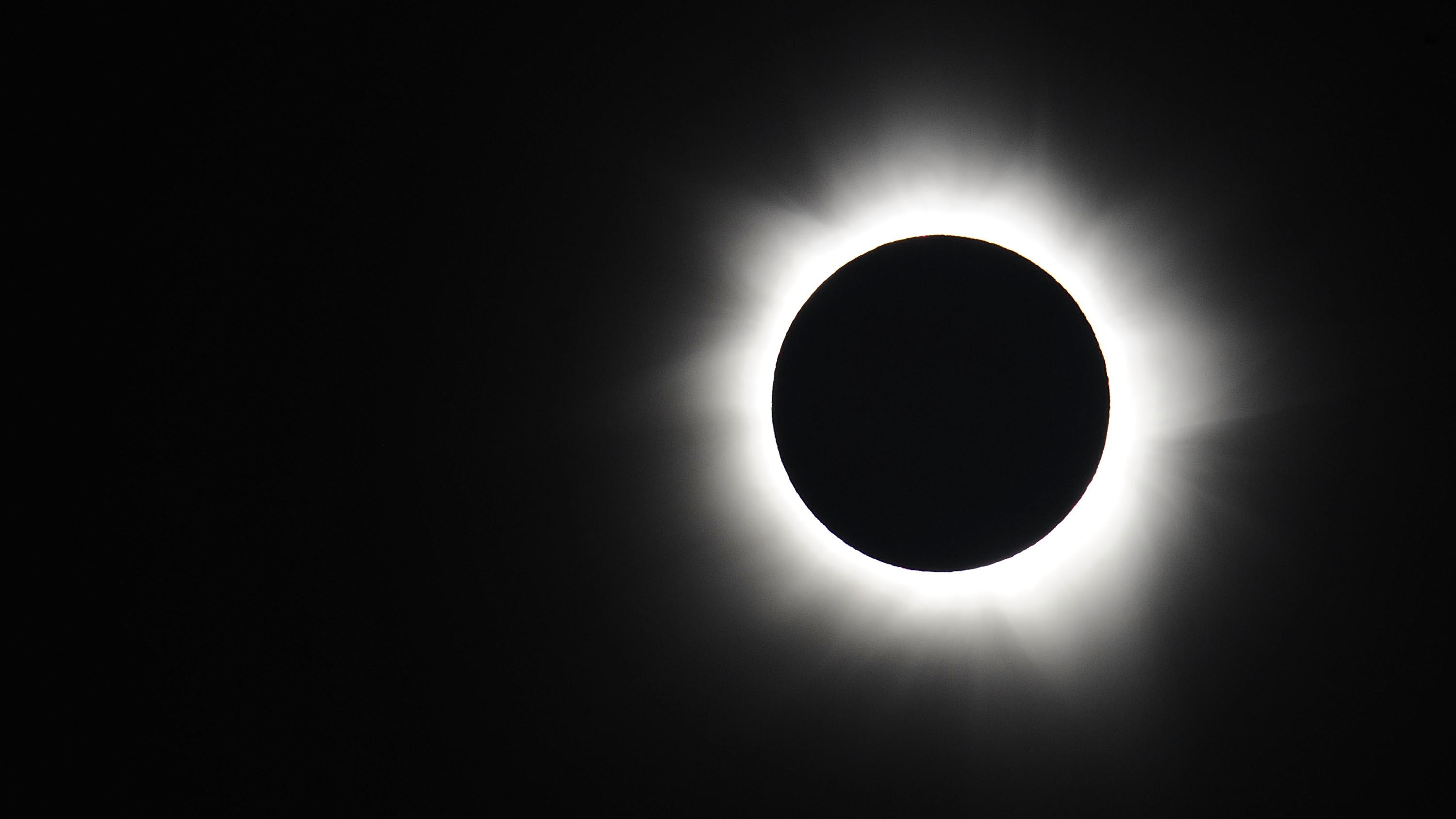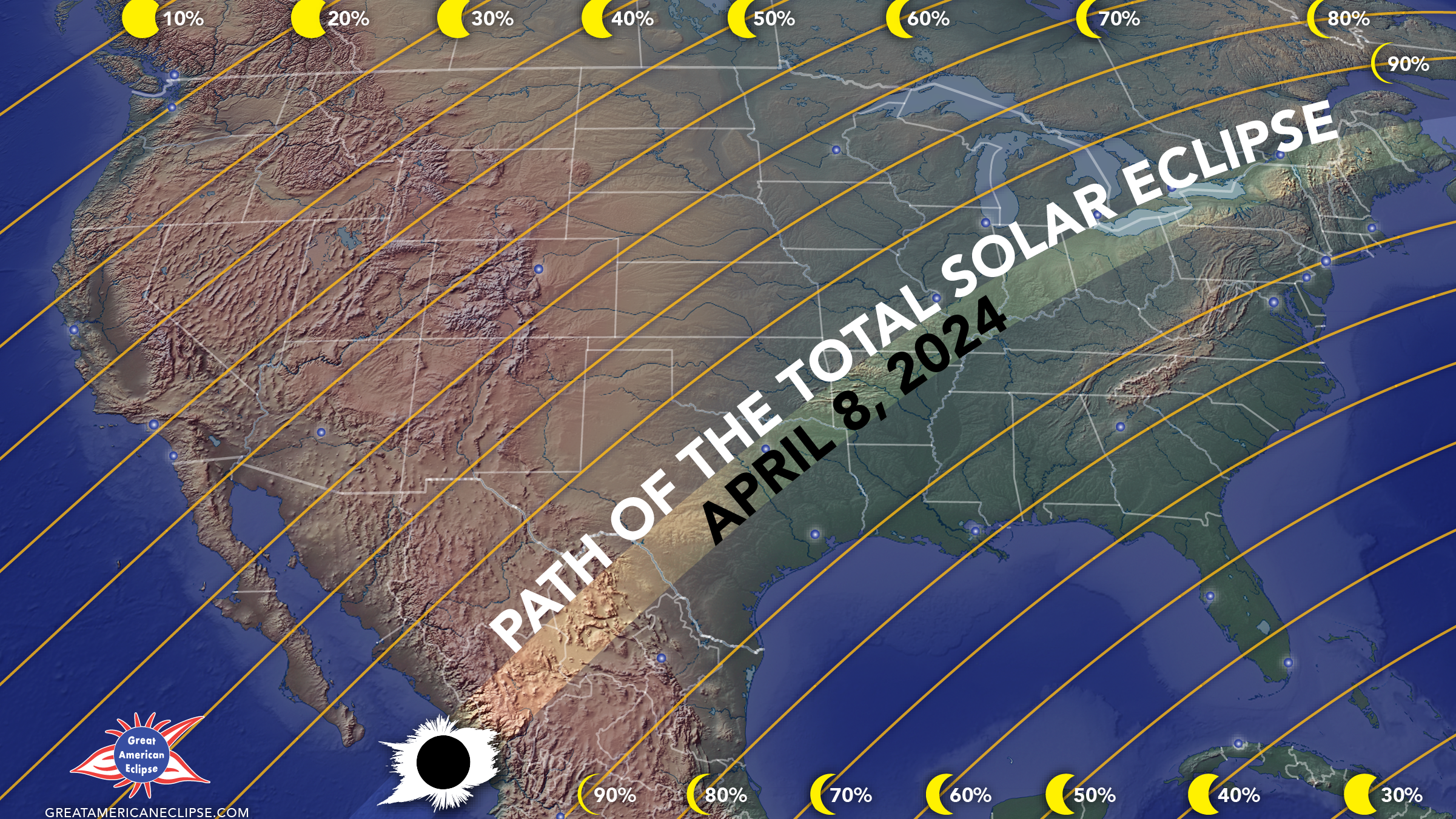Solar maximum: Why April's total Solar Eclipse will bring unique views of the sun's corona
With the solar cycle set to peak earlier than predicted, the sun's corona should look its spectacular spiky best for April 8's total solar eclipse.

A dramatic view of the sun at' solar maximum' will await eclipse-chasers on April 8, 2024, during North America's total solar eclipse.
Only those within a 125-mile (200 km) wide path of totality can glimpse the sun's corona — its hotter outer atmosphere — with their naked eyes during totality. Only during the exact moment of totality, when the moon completely obscures the sun can you look with the naked eye. At all other times, precautions need to be taken. It's a sight to behold, whatever the level of solar activity, but the latest predictions have the sun reaching the peak of its current cycle in 2024, the corona now looks set to be at its largest and spikiest just in time for totality. With cameras much improved since the last solar maximum in 2012, unique images will be possible.
Related: Solar maximum will arrive sooner and last longer than previously expected, say scientists
REMEMBER to NEVER look at the sun directly. To safely view this solar eclipse you must use solar filters at all times. Only during the exact moment of totality, when the moon completely obscures the sun can you look with the naked eye. At all other times, precautions need to be taken. Observers will need to wear solar eclipse glasses, and cameras, telescopes and binoculars must have solar filters placed in front of their lenses.
Solar maximum vs solar minimum
According to a statement from solar physicists at NOAA's Space Weather Prediction Center (SWPC), the sun will now peak in its current activity cycle between January and October 2024, a year earlier than previous estimates.
The sun has a cycle of roughly 11 years, during which it waxes and wanes between solar minimum and solar maximum. It's a cycle driven by the sun's magnetic field. The number of sunspots on its surface is how scientists figure out at what stage of the cycle the sun is at.
How solar maximum affects the corona
"A total solar eclipse provides a unique opportunity to view the sun's atmosphere, the corona, with the naked eye," said Dr. Ryan French, a solar physicist at the National Solar Observatory (NSO) in Boulder, Colorado and the author of The Sun: Beginner's Guide To Our Local Star, in an email to Space. "But the corona is always changing and its appearance depends on the level of solar activity."
Breaking space news, the latest updates on rocket launches, skywatching events and more!
During totality at a total solar eclipse, the naked eye sees the difference between the two extremes, which is obvious. "At solar minimum, when the sun is quiet, structure in the corona is confined to the equators," said French. "Long, stretching 'streamers' and visible emanating from the sun." However, during a solar maximum eclipse-chasers can expect some activity in the corona stretching beyond the equators and up to the poles. "If you see an eclipse during this active period, the sun's corona may look like the traditional 'star' shape that you likely drew as a child, with streamers pointing in all directions," said French.
How solar maximum affects prominences
Something else that tends to be more evident during a total solar eclipse during solar maximum is the prominences around the moon's limb. A bright pinkish-red loop to the naked eye, prominences are tangles of magnetic material anchored to the sun's surface and can last for days. However, during solar maximum, the view can be different. "Normally, you find them along the sun's equator, but at solar maximum, you can see stuff everywhere," said Amir Caspi, Principal Scientist at the Southwest Research Institute, who's heading up an experiment using one of NASA's WB-57 high altitude aircraft to study the corona from above most of Earth's atmosphere. "One of the things that you'll see in 2024 is a lot more stuff in the north and south polar regions of the sun that you didn't see in 2017." Back in 2017, most of the prominences were along the equatorial region. This time, not only are they more likely, but they could appear anywhere.
Related: Solar cycle: What is it and why does it matter?
The difference between the sun during total solar eclipses is most easily seen by comparing images from expert eclipse photographer Fred Espenak. For example, this image taken close to the last solar minimum on July 2, 2019, in Chile shows the corona at its smallest, more or less, with defined streamers at the poles and with few prominences. Fast-forward four years to April 20, 2023, and the sun in eclipse is closer to solar maximum, this time from a cruise ship off Western Australia, showing the corona much larger and more defined, with prominences everywhere.
Why 2024 will be different to 2023
Although the most recent total solar eclipse featured an enlarged corona, it was harder to see visually, which will be the case in 2024. That's because it was a hybrid solar eclipse, where the moon was only just large enough to cover the sun, which it did for just over a minute. "The corona far out is dim, and close to the disk, it's bright," a specialist in the School of Physics & Applied Physics at Southern Illinois University Carbondale and Co-Chair of the Southern Illinois Eclipse 2017-2024 Steering Committee Bob Baer told Space.com. "We saw that again in Australia, where to me visually, the moon almost looked like it didn't cover the solar disk completely so it was super bright right down to the sun's surface." It also didn't get particularly dark during totality. None of that will happen in North America on April 8, when the moon will be closer to Earth and appear larger than the sun. Consequently, the moon will easily cover the sun, and totality will last a lot longer — up to 4 minutes and 28 seconds — and the sky will appear much darker. The corona will be slightly bigger, easier to see, and be visible for much longer.
Related: What states will April 2024 eclipse be visible from?
How to optimize your view of the corona
Generally speaking, the best way to get an excellent corona view during totality is to use a pair of binoculars or a small telescope. However, for this particular eclipse — with the corona expected to be so large — the best way to see it will arguably be to look at it with the naked eye. Only then will you be able to see its extent. One easy way to get a better view than everyone else is to dark adapt your eyes before totality, either by using an eye patch on one eye (and then remaking it and closing the other eye during totality) or by wearing a pair of red welding goggles (which you remove when totality begins).
Related: How to photograph a solar eclipse
Once you've looked at the corona and appreciated its size, there's no better close-up in astronomy than the view of the corona through any pair of binoculars or a small telescope. The former is easy enough to leave hanging around your neck (but just be sure not to point any optical equipment at the un-eclipsed sun — you'll need solar filters for that).
Either way, the view of the sun in eclipse on April 8 should have millions of Americans aiming to reach the path of totality. Those who don't will get a partial solar eclipse and completely miss out on an extraordinary sight.

Jamie is an experienced science, technology and travel journalist and stargazer who writes about exploring the night sky, solar and lunar eclipses, moon-gazing, astro-travel, astronomy and space exploration. He is the editor of WhenIsTheNextEclipse.com and author of A Stargazing Program For Beginners, and is a senior contributor at Forbes. His special skill is turning tech-babble into plain English.


